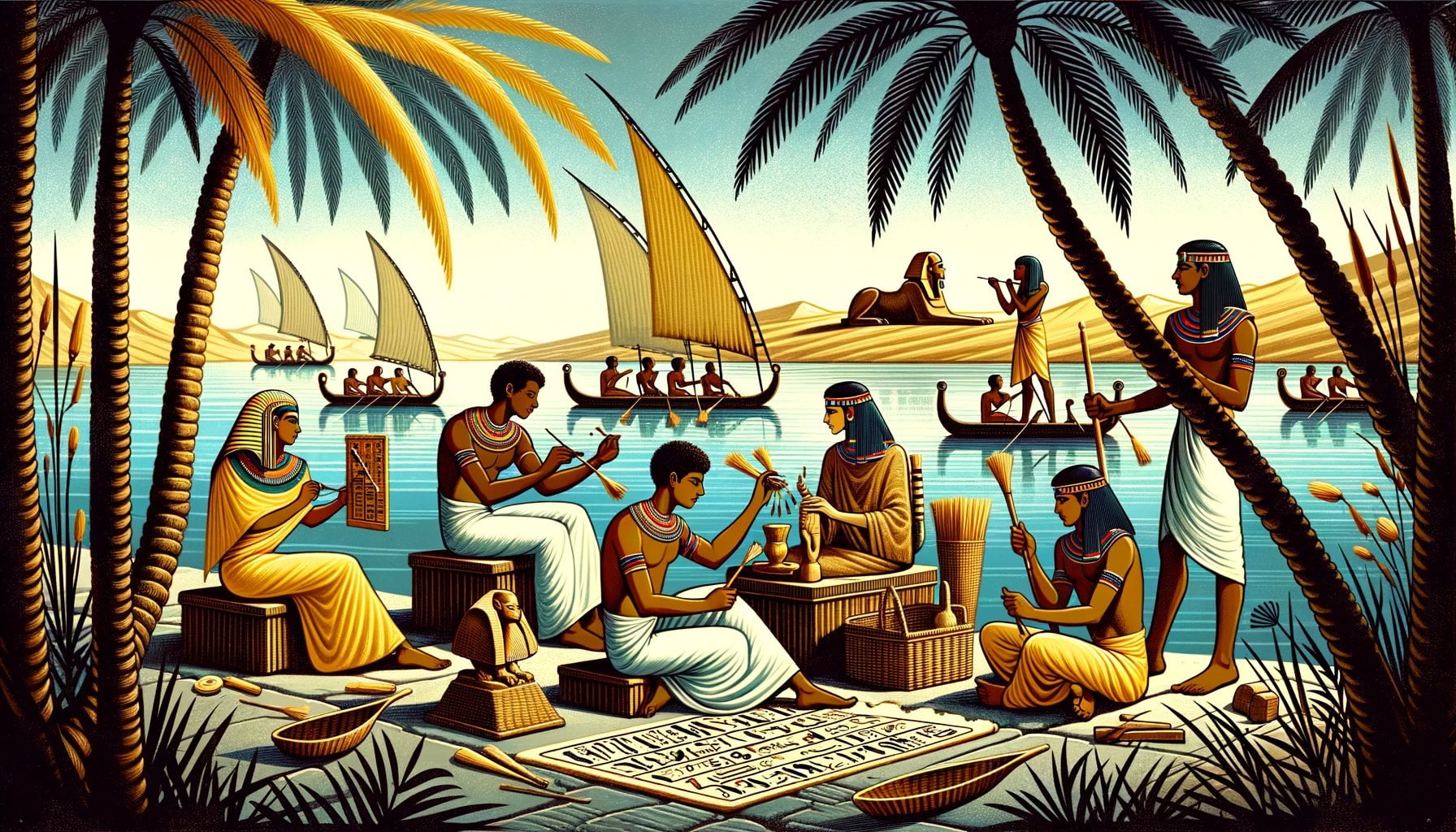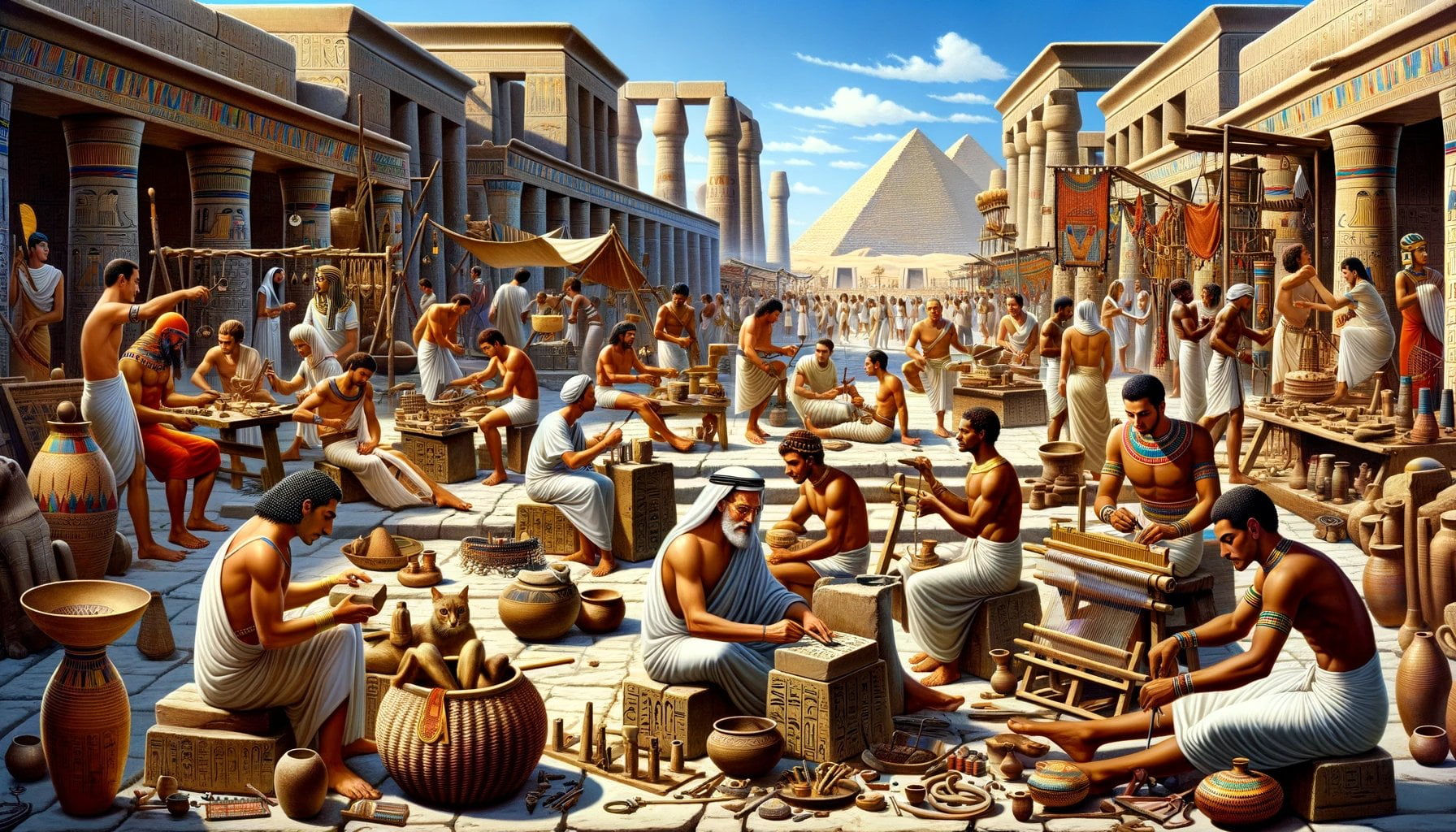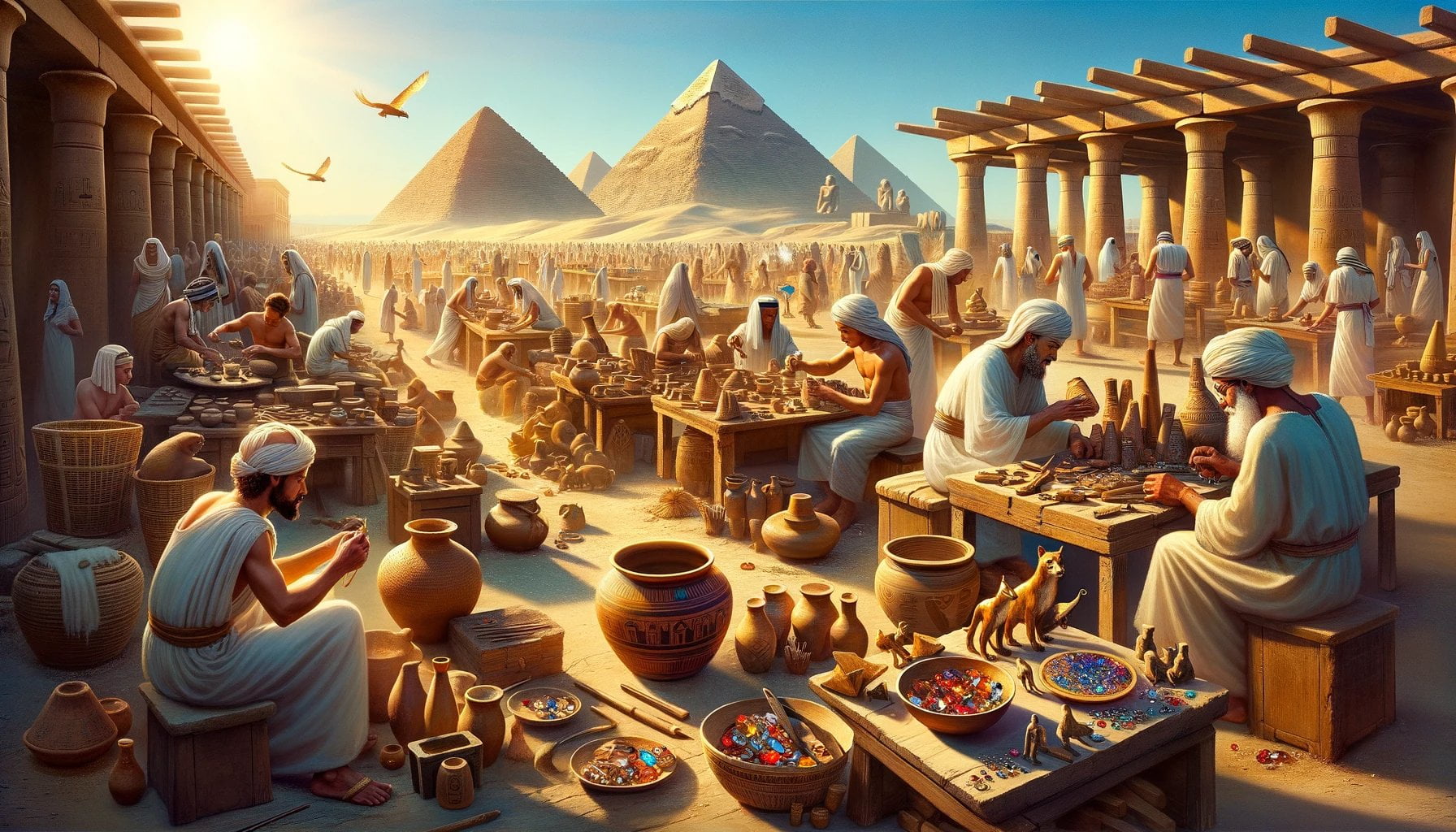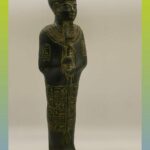Step back in time to the illustrious world of ancient Egypt, where skilled craftsmen held a vital place in society and contributed immensely to its grandeur. In this captivating journey, we shall explore the multifaceted roles played by these artisans and the remarkable contributions they made to one of history’s most enigmatic civilizations. From intricately carved statues and opulent tomb decorations to exquisite jewelry and fine pottery, the craftsmanship of ancient Egypt unveils a remarkable tapestry of skill and creativity. Join us as we delve into the unparalleled artistry and unrivaled contributions of the craftsmen who shaped the cultural and economic landscape of ancient Egypt.
Key Takeaways:
- Craftsmen in ancient Egypt were highly skilled laborers specializing in various fields, including carpentry, stonemasonry, sculpting, blacksmithing, and pottery.
- They created a wide range of goods, such as protective amulets, tomb paintings, pottery figures, and painted pottery, using materials like stones, clay, wood, fibers, ivory, and metals.
- Their craftsmanship was integral to the design and construction of various aspects of Egypt, including tomb decorations, monumental statues, jewelry, and pottery.
- Ancient Egyptian craftsmen used a variety of tools, such as saws, axes, chisels, and paints made from pigments, inks, metals, woods, ivory, bone, glass, flax, and stone.
- Their artifacts were highly valued and usually only affordable for the nobility or wealthy middle class, highlighting their importance and the quality of their work.
- Craftsmen played a vital role in shaping and preserving the cultural heritage of Egypt, contributing to its economy and being highly sought after by both the ruling elite and common people.
What Did Craftsmen Do in Ancient Egypt?

In ancient Egypt, the contribution of craftsmen was indispensable to the cultural and economic fabric of the civilization. These skilled artisans specialized in a variety of crafts, including carpentry, stonemasonry, sculpting, blacksmithing, and pottery, among others. Through their expertise, they created a wide range of exquisite goods that held great significance to both the ruling elite and the common people.
1. Crafting High-quality Goods
Craftsmen in ancient Egypt were known for their ability to produce high-quality goods that served various purposes. From protective amulets to tomb paintings, magical enchantments on papyrus, and funeral jars, their craftsmanship covered a diverse array of items. They were also responsible for creating painted pottery, pottery figures, cartouches, hieroglyphics, ivory grave goods, protective weapons, boats, and barks.
2. Mastery of Different Crafts
Ancient Egyptian craftsmen excelled in multiple disciplines. Their expertise in metalworking allowed them to manipulate copper, gold, and other metals into intricate designs. They were adept carpenters, skillfully shaping wood to construct furniture, boats, and architectural elements. Stonemasonry and sculpting were integral to their craft, as they chiseled and shaped stones to create monumental statues and intricate tomb decorations. Additionally, their mastery of pottery production and textile manufacturing contributed to the creation of beautifully decorated vessels and fine textiles.
3. Use of Various Tools and Materials
Craftsmen in ancient Egypt relied on an assortment of tools and materials to bring their creations to life. They employed saws, axes, and chisels for woodworking, and used pigments, inks, metals, woods, ivory, bone, glass, flax, and stone to paint and decorate their art pieces. The range of materials they worked with expanded over time, incorporating stones, clay, wood, fibers, ivory, animal skins, bones, feathers, and eventually, metals.
4. Societal Significance and Economic Role
Craftsmen held great value in ancient Egyptian society, and their creations were highly sought after. While the nobility and wealthy middle class could afford their exquisite artifacts, craftsmen also catered to the needs of the common people. Their goods held not only economic value but also cultural significance, as their work played a vital role in shaping and preserving the heritage of Egypt.
Conclusion
Ancient Egyptian craftsmen were instrumental in the development and prosperity of the civilization. Their diverse skills and expertise allowed them to contribute to various aspects of Egyptian life, whether it was through the creation of beautiful art pieces, the construction of essential objects, or the provision of economic prosperity. Through their craftsmanship, they transformed raw materials into objects of beauty, leaving a lasting legacy that continues to awe and inspire us today.
In ancient Egypt, there were three powerful kingdoms that shaped its history. Curious to know what they were? Check out our article on what are the 3 kingdoms of ancient Egypt to uncover this fascinating piece of history.
Ancient Kourion in Cyprus is a site that is rich in archaeological wonders. If you’re interested in exploring this ancient city, click here to learn more about ancient Kourion Cyprus and its fascinating history.
Interested in the origins of the warrior concept in ancient Greece? Discover the ancient Greek word for warrior and delve into the history of these formidable fighters. Find out more by clicking on ancient Greek word for warrior.
Ancient China is known for its illustrious history and remarkable individuals. Want to learn more about the famous people who shaped ancient China? Click here to explore our article on famous people in ancient China and discover their incredible stories.
The crocodile god played an intriguing role in ancient Egyptian mythology. Unearth the mysteries surrounding this ancient deity by clicking here and exploring our article on the crocodile god ancient Egypt.
Searching for ancient pagan names? Look no further! Discover a myriad of enchanting and unique names from ancient civilizations by clicking on ancient pagan names. Let these names transport you to another time and place.
The significance of craftsmen in ancient Egyptian society
Craftsmen in ancient Egypt held a significant role in shaping the civilization’s economy, culture, and religious practices. Their skills and expertise were highly valued, and their creations left a lasting impact on Egyptian history.
Craftsmen in ancient Egypt were skilled artisans who specialized in various crafts, including stonemasonry, carpentry, sculpting, pottery making, blacksmithing, weaving, spinning, glass-blowing, dressmaking, and scribing. They worked in workshops alongside their peers, creating finely crafted objects primarily for the pharaoh and wealthy individuals.
The range of goods produced by Egyptian craftsmen was vast and diverse. They created protective amulets, tomb paintings, magical enchantments on papyrus, funeral jars, painted pottery, pottery figures, painted scenes, cartouches, hieroglyphics, ivory grave goods, protective weapons, boats and barks, and other goods that were believed to protect and sustain life.
Craftsmen enjoyed a high status in ancient Egyptian society and lived comfortable lives. However, it is notable that they were not allowed to sign their work, even when sculpting statues for pharaohs. This signifies the collective effort and importance of the craft rather than individual recognition.
The role of craftsmen extended beyond their artistic endeavors. They played a vital role in the economy as their creations were highly sought after and exchanged as trade goods. They contributed to the cultural heritage of Egypt by preserving artistic traditions and passing down their skills and knowledge through generations.
Craftsmen also had a significant impact on religious practices in ancient Egypt. Their creations, such as tomb decorations and amulets, played a crucial role in religious rituals and beliefs. These objects were believed to hold protective powers and were used to ensure the well-being and afterlife of the deceased.
In conclusion, craftsmen in ancient Egypt were essential contributors to the society’s economy, culture, and religion. Their skills and expertise were highly valued, and their creations left a profound impact on Egyptian civilization. Through their meticulous craftsmanship and dedication, these artisans shaped the artistic legacy of ancient Egypt.
Key Takeaways:
– Craftsmen in ancient Egypt were skilled artisans who specialized in various crafts such as stonemasonry, carpentry, sculpting, pottery making, and weaving.
– They created a wide range of objects, including tomb decorations, magical enchantments, funeral jars, pottery, and protective weapons.
– Craftsmen had a high status in Egyptian society, but they were not allowed to sign their work, emphasizing the collective effort and importance of the craft.
– Their creations contributed to the economy, cultural heritage, and religious practices of ancient Egypt.
– Craftsmen played a vital role in preserving artistic traditions and passing down their skills through generations.
Sources:
– Egypt Tours Portal
– Ancient Egypt
Economic Aspects of Craftsmanship in Ancient Egypt
Craftsmen in ancient Egypt had a significant impact on the economy of the civilization. Through their exceptional skills and craftsmanship, they contributed to the prosperity and success of their communities. Let’s explore the economic aspects of craftsmanship in ancient Egypt.
Wealthy Clientele and High-Quality Products
The creations of craftsmen in ancient Egypt were highly sought after by the nobility and the wealthy middle class. These affluent individuals could afford the exquisite and high-quality goods produced by the skilled artisans. From jewelry and pottery to papyrus products and tools, craftsmen crafted a wide range of goods that catered to the needs and desires of their distinguished clientele. The economic aspect of craftsmanship can be seen in the fact that most of these artifacts were not affordable for the general population, further highlighting the social status of the craftsmen.
Economy and Trade
Craftsmen in ancient Egypt played a vital role in the economy of the civilization. Their creations were in high demand, not just within the boundaries of Egypt but also in trade with neighboring regions. The success and prosperity of craftsmen were closely linked to the vibrant trade networks of ancient Egypt. The export of their skillfully crafted products brought wealth and economic stability to their communities.
Training and Apprenticeships
Craftsmen learned their skills through rigorous training and apprenticeships. Their expertise was honed over time, allowing them to create masterpieces of art and craftsmanship. This training not only ensured the preservation of artistic traditions but also provided craftsmen with a comfortable lifestyle within their communities. The economic aspect of craftsmanship can be seen in the fact that highly skilled craftsmen were highly valued and sought after, both within and outside Egypt.
Societal Significance
Craftsmen held a unique position in Egyptian society. While they were socially superior to common laborers, they were not part of the ruling elite. Craftsmen belonged to the middle class, alongside skilled workers such as physicians. Their role in society went beyond mere economic contributions. They played a vital role in shaping and preserving the cultural heritage of Egypt, contributing to the religious practices, and leaving a legacy for future generations.
Key Takeaways:
- Craftsmen in ancient Egypt catered to the wealthy and the nobility, creating high-quality products that were not affordable for the general population.
- Their skills and craftsmanship contributed to the vibrant trade networks of ancient Egypt, bringing economic prosperity to their communities.
- Craftsmen learned their skills through rigorous training and apprenticeships, allowing them to create masterpieces of art and craftsmanship.
- They held a unique position in Egyptian society, belonging to the middle class and playing a vital role in preserving the cultural heritage of Egypt.
Sources:
– Facts About Ancient Egyptian Craftsmen – Egypt Tours Portal
– What Did Craftsmen Do In Ancient Egypt? – Knowledge WOW
The relationship between craftsmen, the ruling elite, and the common people in ancient Egypt
Ancient Egypt, a civilization known for its remarkable craftsmanship and cultural achievements, had a complex and interconnected relationship between craftsmen, the ruling elite, and the common people. Let’s explore how these three groups interacted and influenced each other within Egyptian society.
Craftsmen and the Ruling Elite
Ancient Egyptian craftsmen held a significant role in serving the ruling elite, which included pharaohs, high-ranking officials, and temple priests. These skilled artisans were responsible for creating exquisite artworks, luxurious furniture, and monumental structures that symbolized wealth, power, and social status within society. Their creations were primarily accessible to the ruling elite, who commissioned and owned these masterpieces. Craftsmen were employed by the pharaohs, centralized government, or temple priests, operating within a hierarchical system. Master craftsmen held higher positions, overseeing the work of apprentices and assistants. Craftsmen’s skills were highly valued and passed down through generations via apprenticeships and training programs. This prestigious occupation allowed craftsmen to leave a lasting impact on the cultural and artistic heritage of ancient Egypt.
Craftsmen and the Common People
Although the works of craftsmen were primarily enjoyed by the ruling elite, they also catered to the needs of the common people. Craftsmen played a vital role in shaping and preserving the cultural heritage of Egypt, creating high-quality products that were sought after by the common people. Their craftsmanship contributed to the economy through trade networks, both within Egypt and with neighboring regions. For the common people, craftsmen produced a variety of everyday tools, household items, and practical objects. These skilled artisans ensured that the common people had access to the necessary tools and implements for their daily lives. Craftsmen held a unique position in Egyptian society, being socially superior to common laborers but not part of the ruling elite.
The Significance of Craftsmen
Craftsmen in ancient Egypt served as the bridge between the ruling elite and the common people, influencing both spheres of society. The exquisite creations of craftsmen represented the wealth and status of the ruling elite, while also meeting the needs of the common people. Their craftsmanship contributed to the economy and cultural heritage of ancient Egypt. Craftsmen played a vital role in preserving artistic traditions and passing down their skills through generations. The relationship between craftsmen, the ruling elite, and the common people was intertwined and interconnected, with each group depending on the other for their societal roles and contributions.
Key Takeaways:
- Ancient Egyptian craftsmen served the ruling elite, creating exquisite artworks and structures that symbolized wealth and power.
- Craftsmen operated within a hierarchical system, with master craftsmen overseeing apprentices and assistants.
- Craftsmen catered to the needs of the common people, producing everyday tools and practical objects.
- Craftsmen played a vital role in shaping and preserving the cultural heritage of Egypt, contributing to the economy and trade networks.
- The relationship between craftsmen, the ruling elite, and the common people was interconnected, with each group relying on the other for their societal roles and contributions.
Sources:

FAQ
Q1: What were the different crafts that ancient Egyptian craftsmen specialized in?
A1: Ancient Egyptian craftsmen were skilled in various crafts, including stonemasonry, carpentry, sculpting, pottery making, blacksmithing, weaving, spinning, glass-blowing, dressmaking, and scribing.
Q2: What kind of goods did Egyptian craftsmen produce?
A2: Egyptian craftsmen produced a wide range of goods, including jewelry, pottery, papyrus products, tools, protective amulets, tomb paintings, funeral jars, painted pottery, painted scenes, cartouches, hieroglyphics, ivory grave goods, protective weapons, boats, and barks.
Q3: What materials did ancient Egyptian craftsmen use in their work?
A3: Ancient Egyptian craftsmen used materials such as stones, clay, wood, fibers, ivory, animal skins, bones, feathers, and later on, metal.
Q4: Who were the clients of ancient Egyptian craftsmen?
A4: The clients of ancient Egyptian craftsmen were primarily the pharaohs, high-ranking officials, and temple priests, who belonged to the ruling elites and the upper class of society.
Q5: What was the social status of ancient Egyptian craftsmen?
A5: Ancient Egyptian craftsmen held a high social status and were considered socially superior to common laborers due to their incredible skills and artistic talents. They were part of the middle class in ancient Egyptian society, along with other skilled workers like physicians.
- Amazing March Fun Facts: Unveiling History & Celebrations - April 15, 2025
- Master how to write height: A complete guide - April 15, 2025
- How High Are Your Standards Test: Find Your Perfect Match Now - April 15, 2025
















